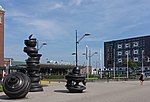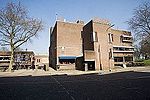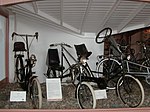Nijmegen railway bridge
Bridges completed in 1879Bridges completed in 1984Bridges in NijmegenBridges over the RhineRailway bridges in the Netherlands ... and 3 more
Rijksmonuments in NijmegenSteel bridges in the NetherlandsTruss bridges

The Nijmegen railway bridge is a truss bridge spanning the River Waal, connecting the city of Nijmegen to the town of Lent in the Netherlands.
Excerpt from the Wikipedia article Nijmegen railway bridge (License: CC BY-SA 3.0, Authors, Images).Nijmegen railway bridge
Spoorbrugkade, Nijmegen Nijmegen-Centrum (Nijmegen)
Geographical coordinates (GPS) Address External links Nearby Places Show on map
Geographical coordinates (GPS)
| Latitude | Longitude |
|---|---|
| N 51.8519 ° | E 5.8566 ° |
Address
Spoorbrug Nijmegen
Spoorbrugkade
6511 XV Nijmegen, Nijmegen-Centrum (Nijmegen)
Gelderland, Netherlands
Open on Google Maps










